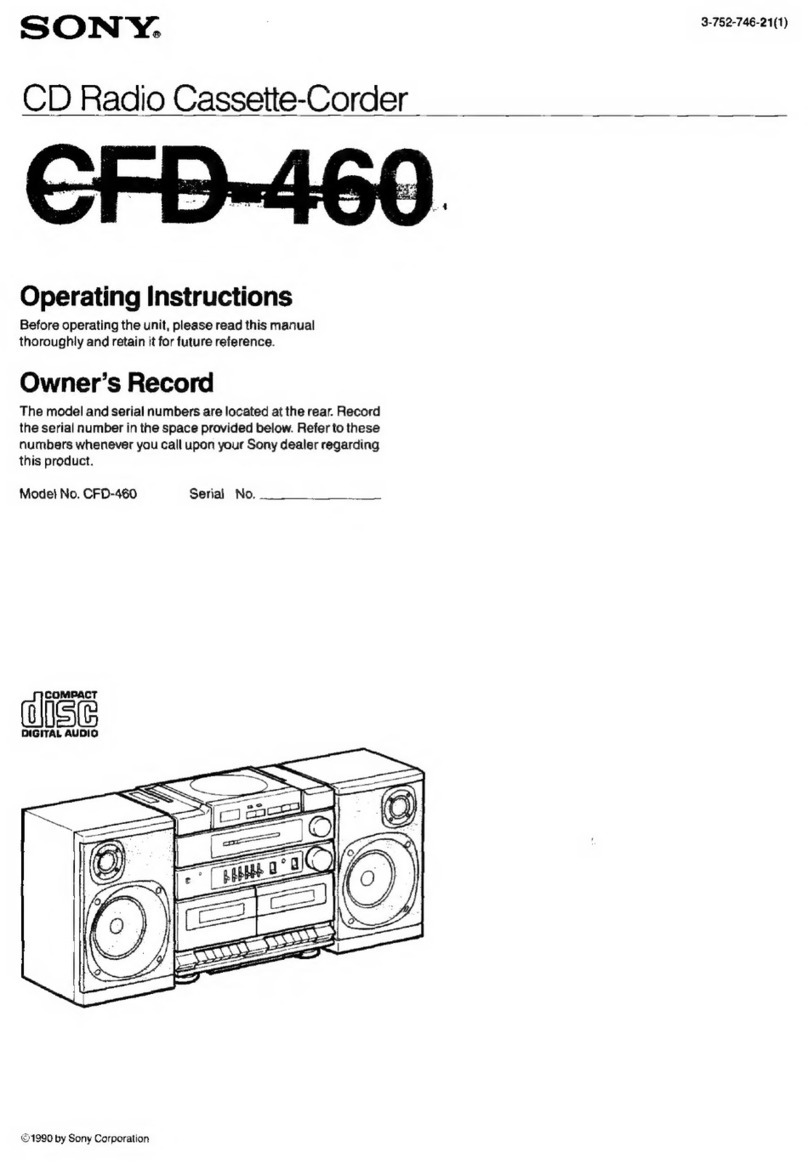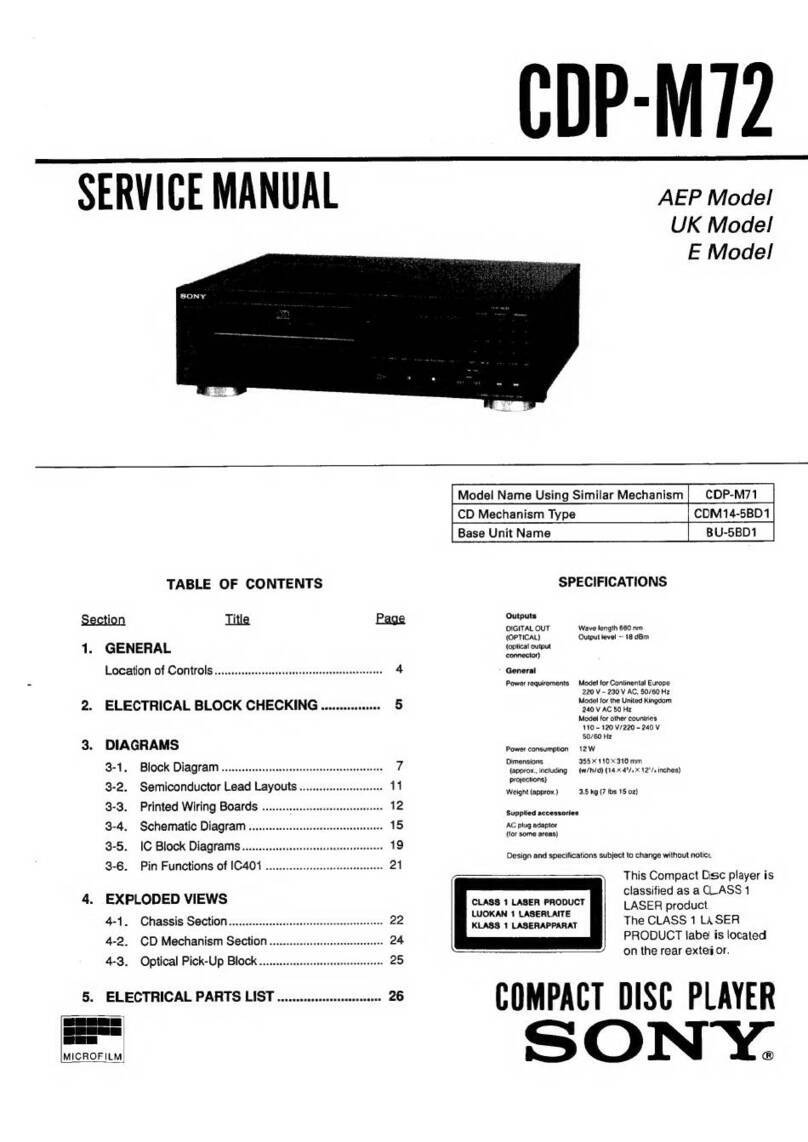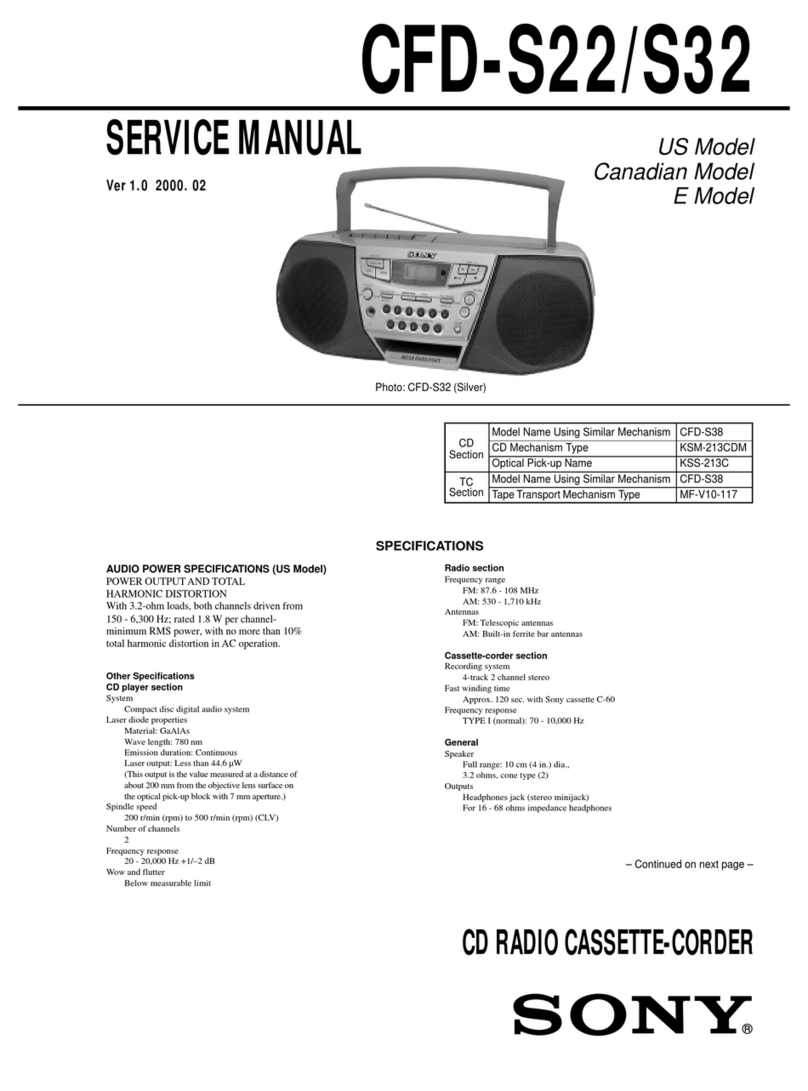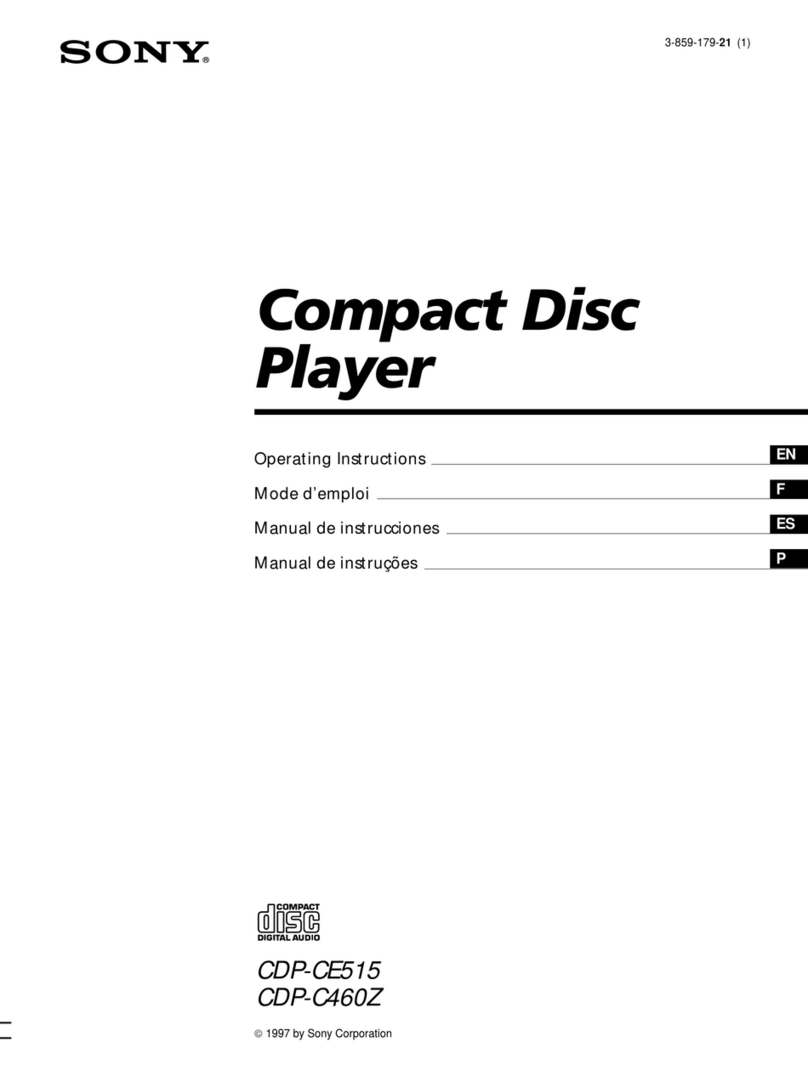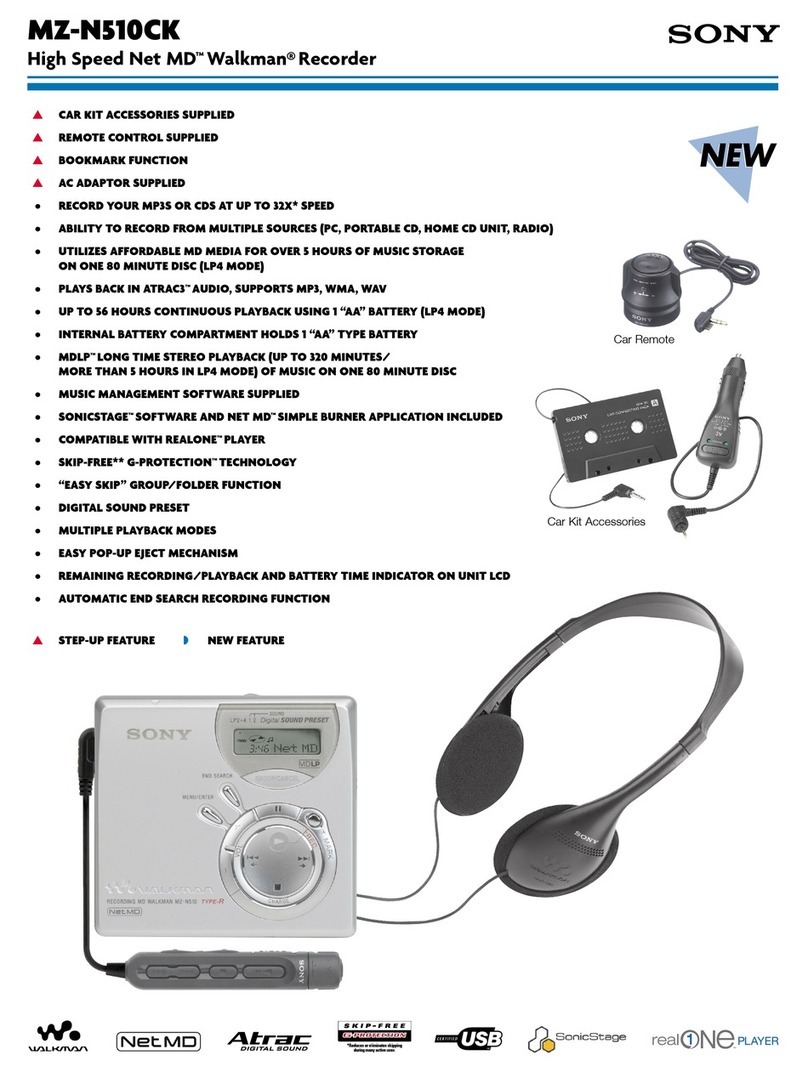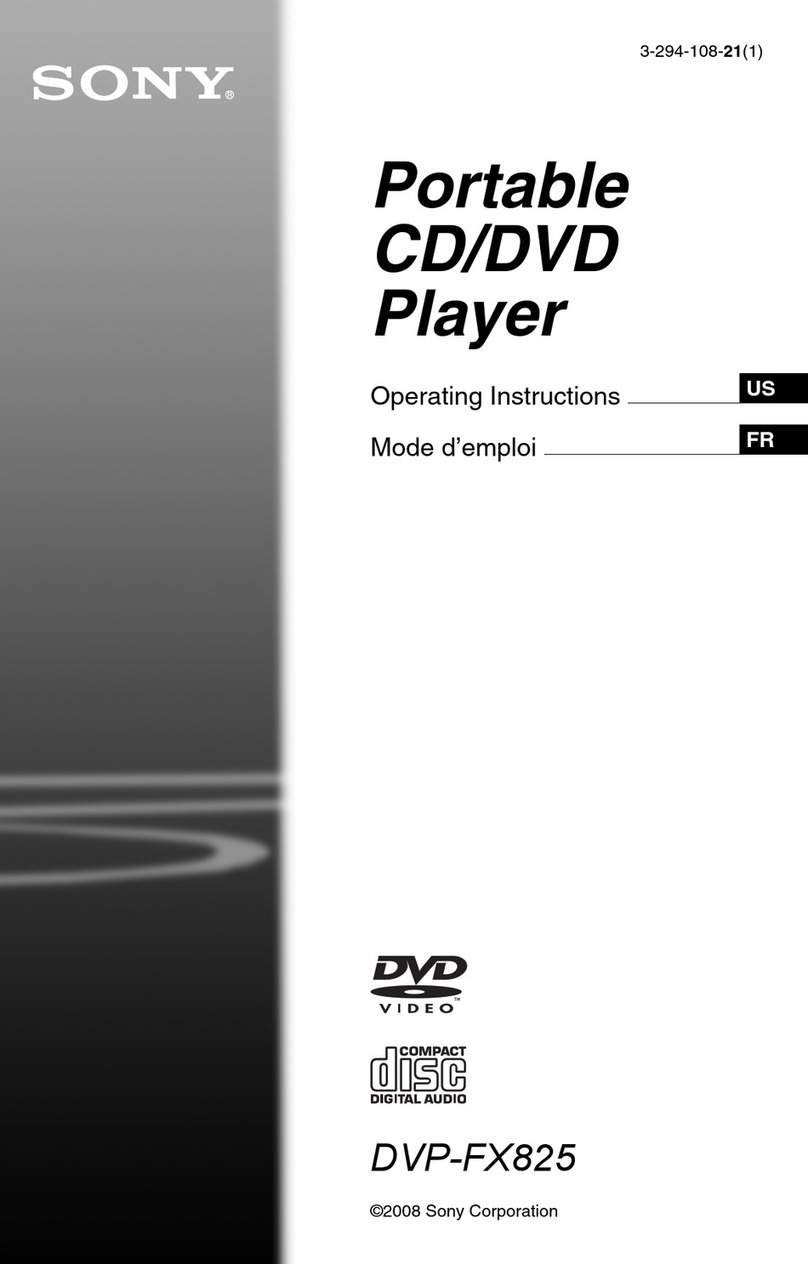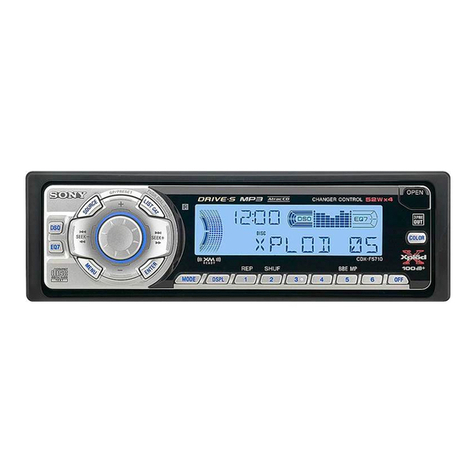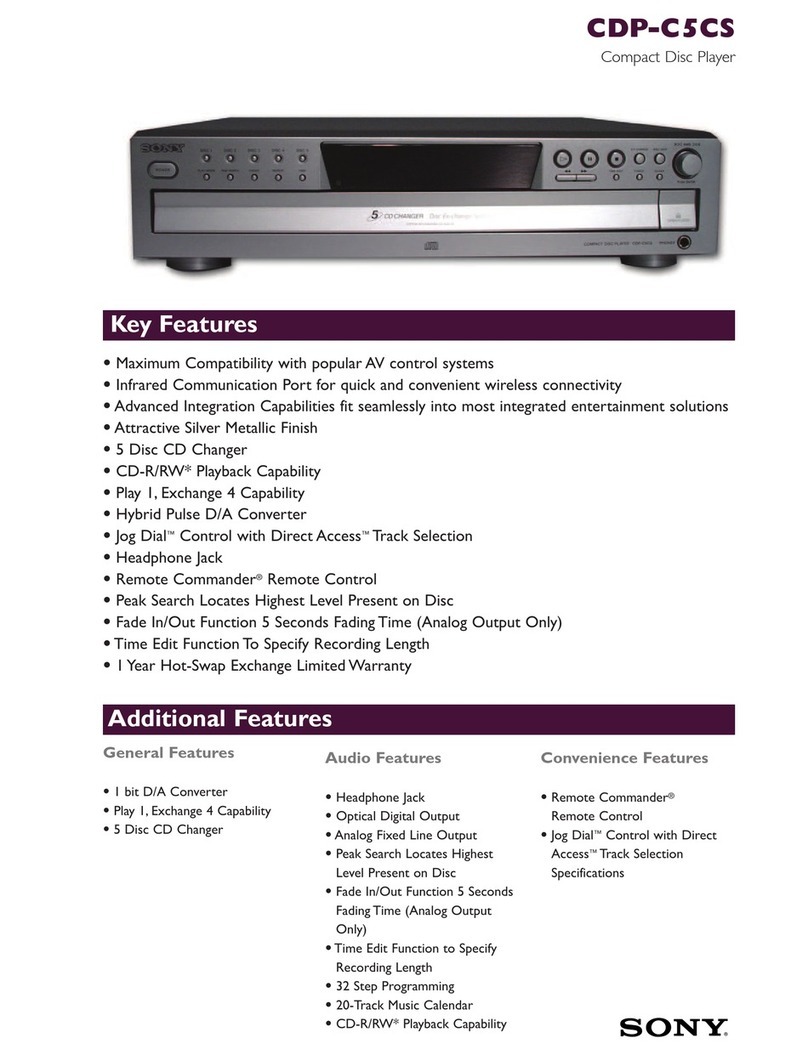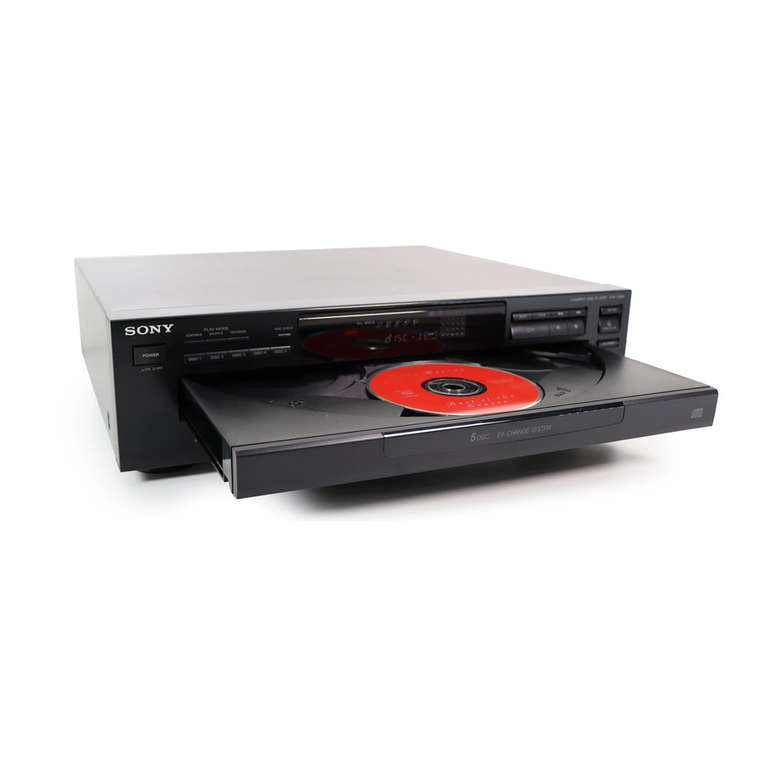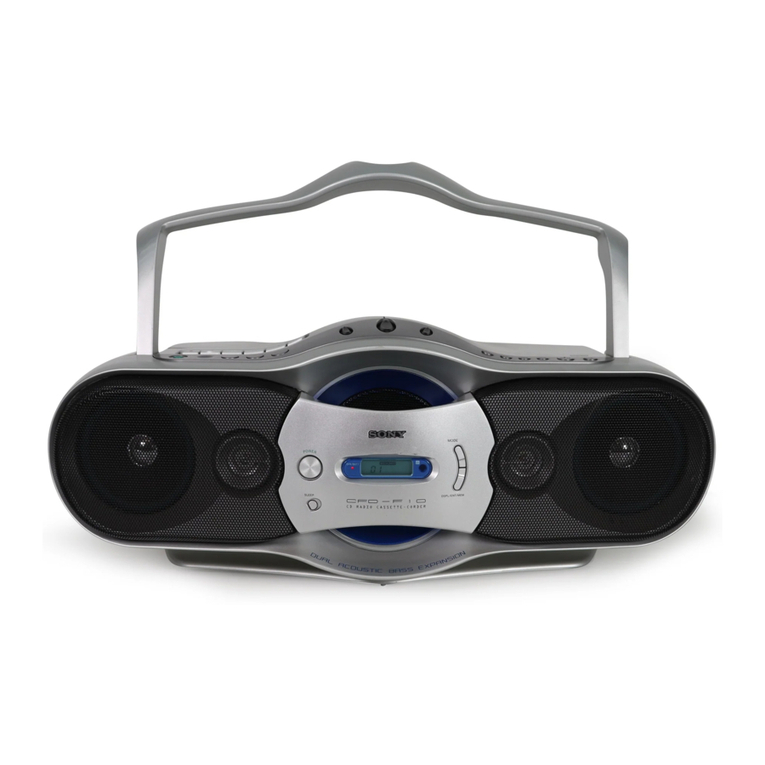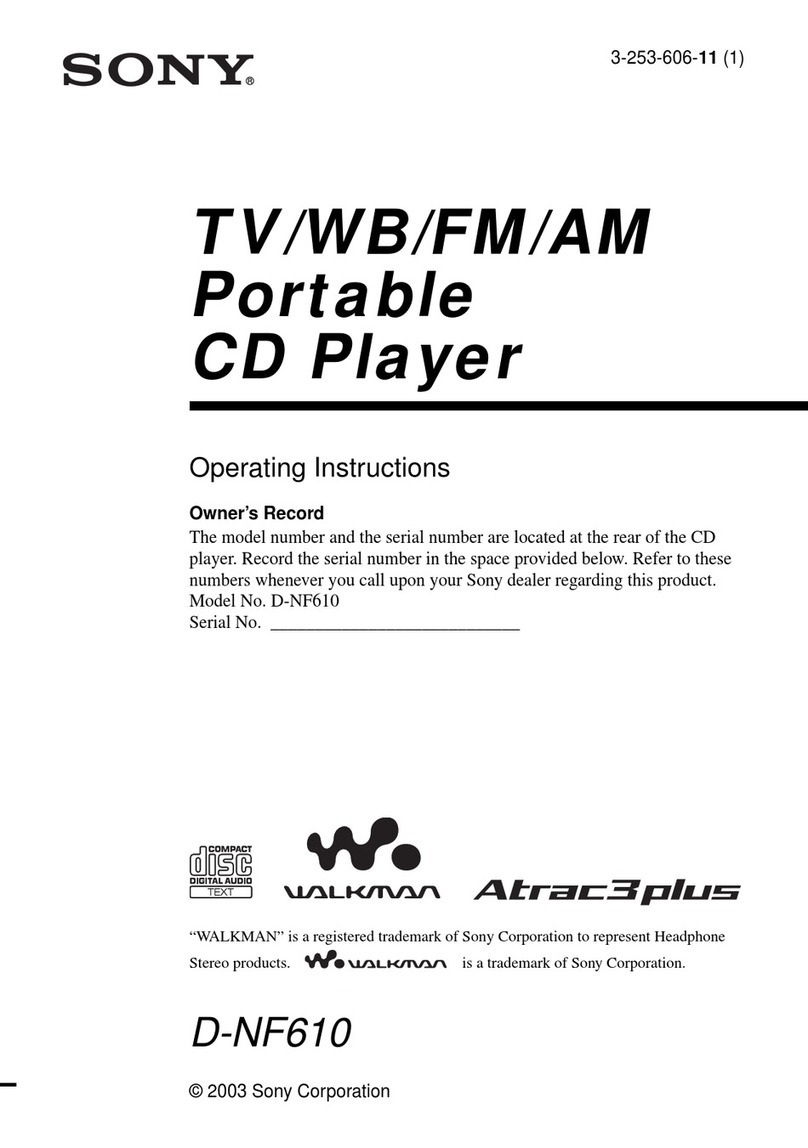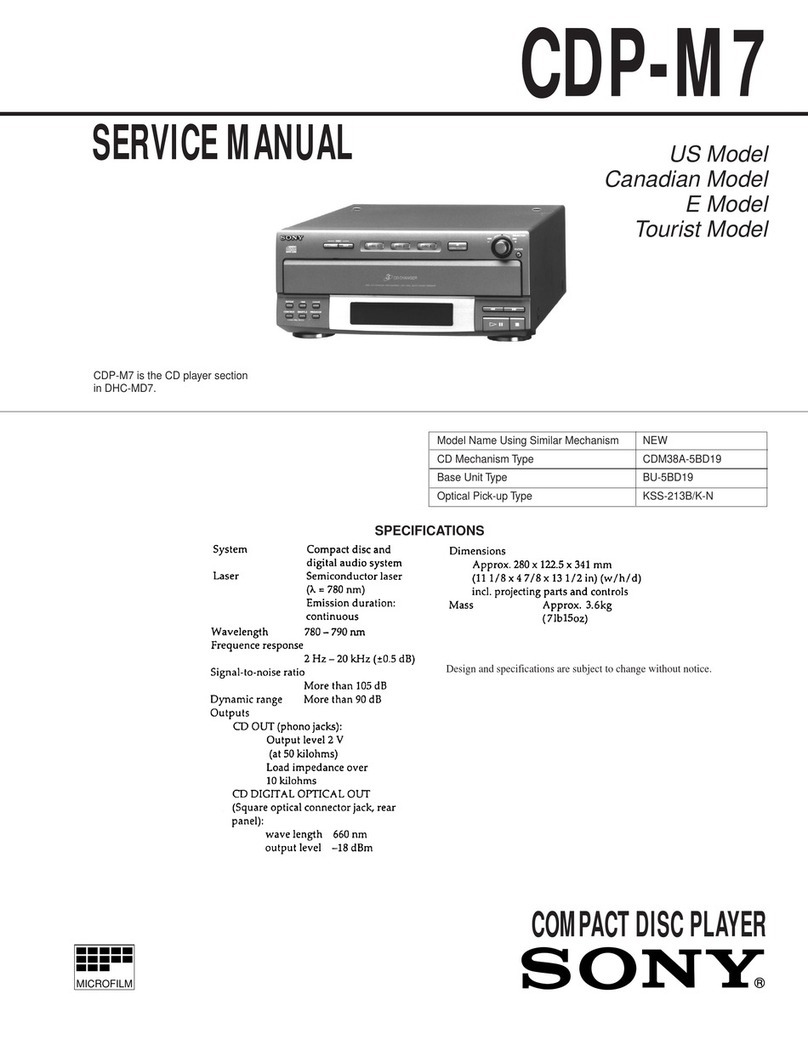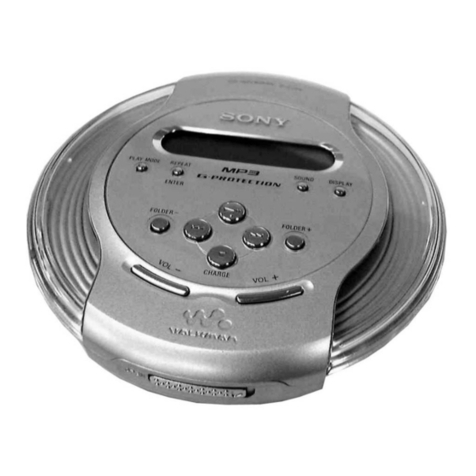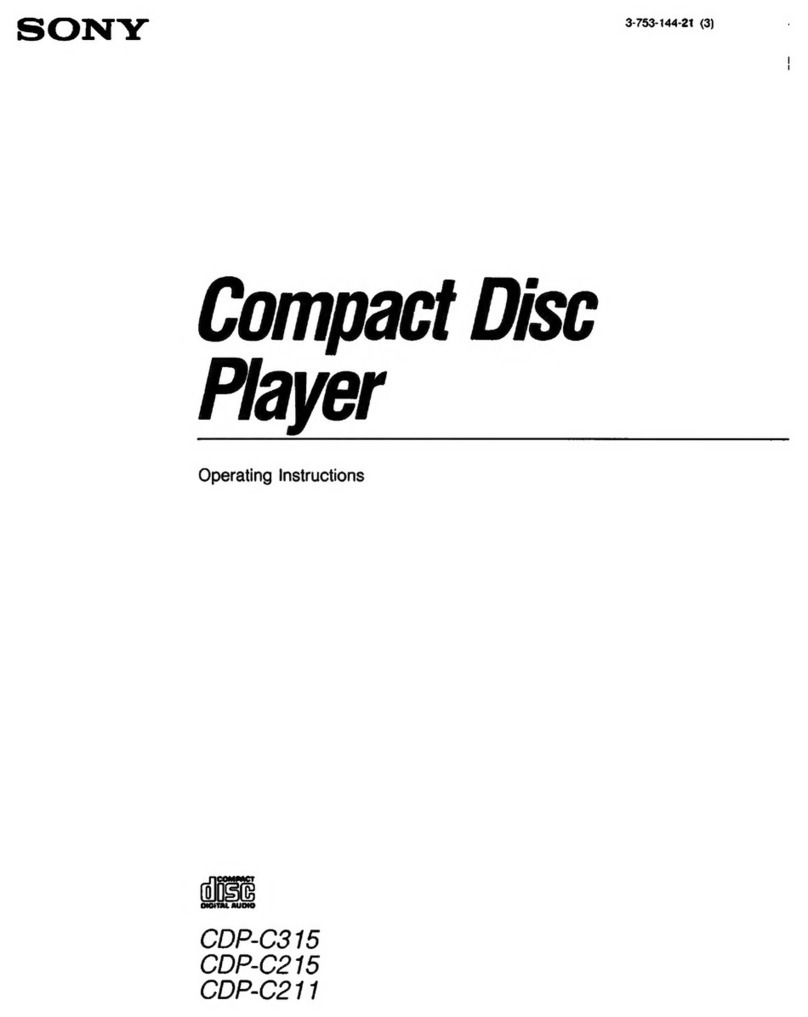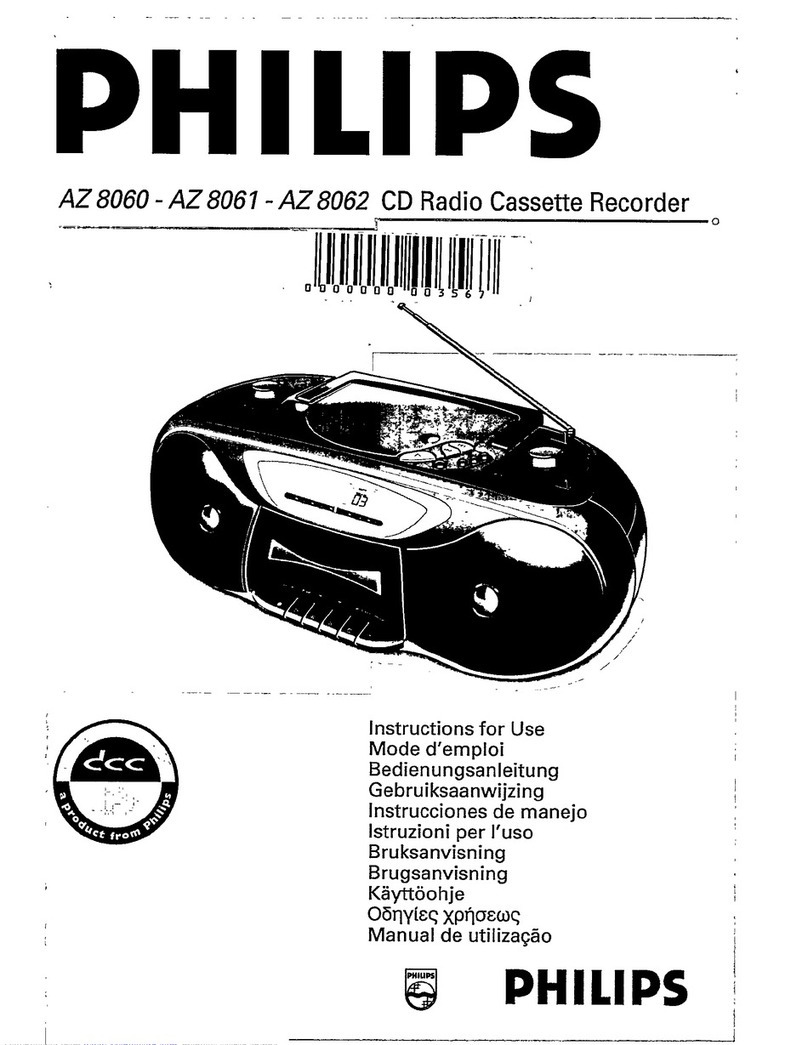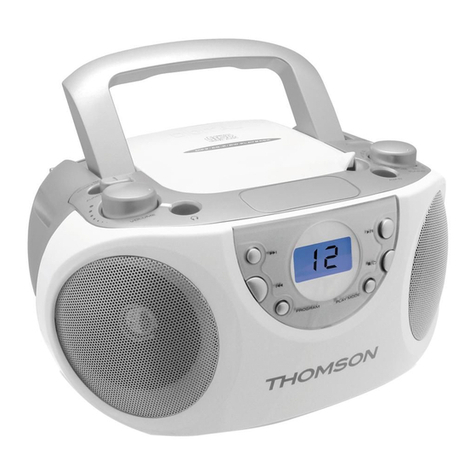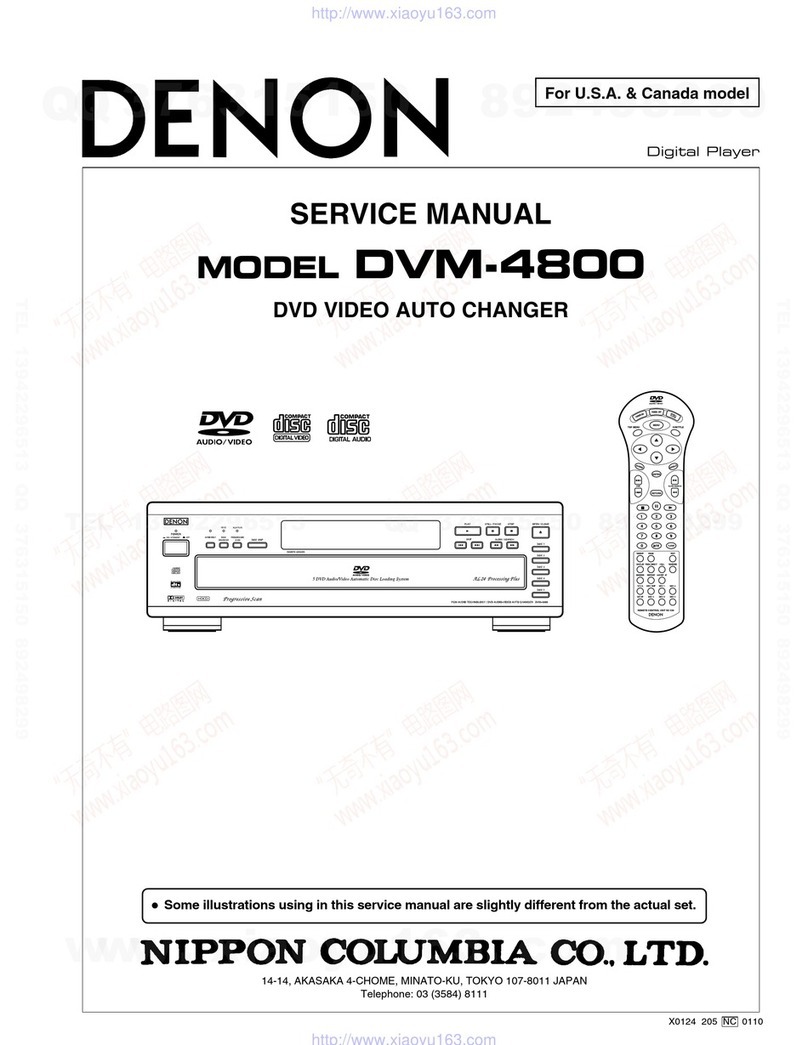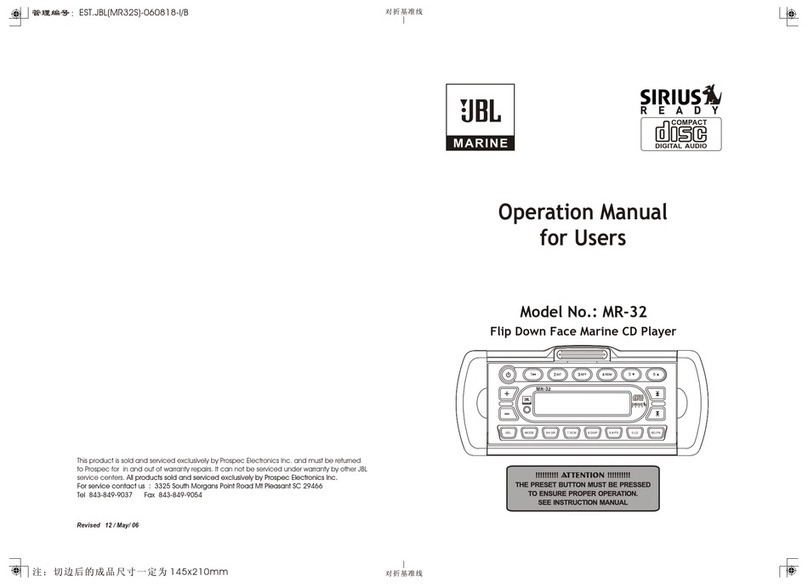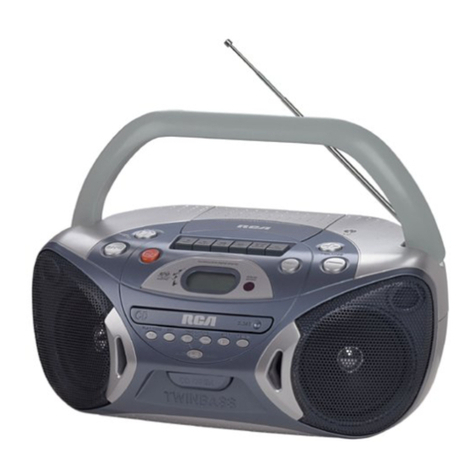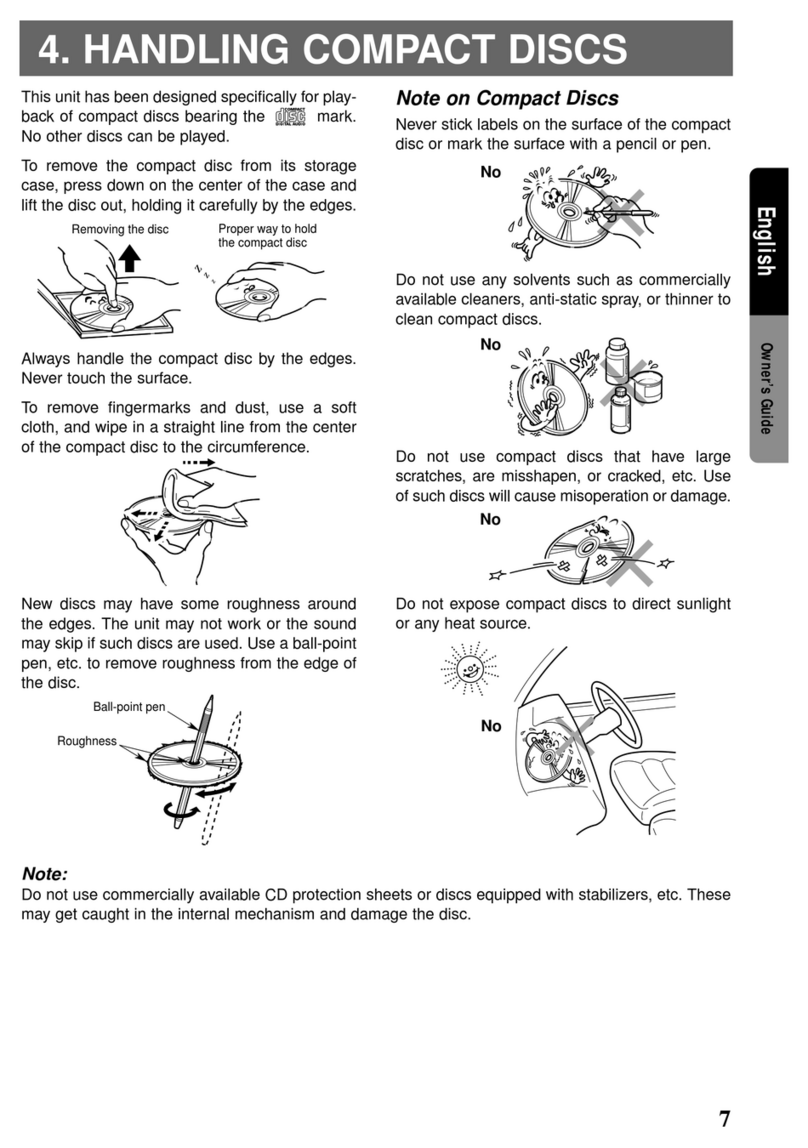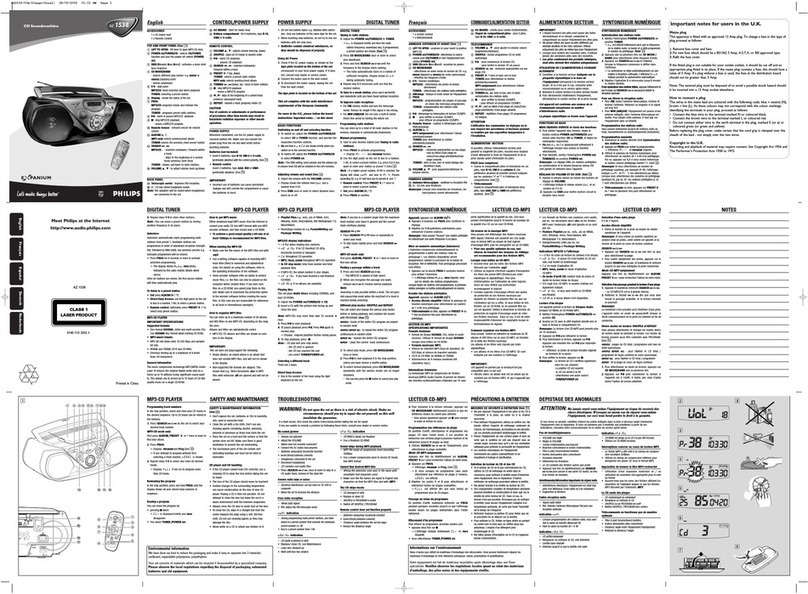
Sony Corporation ©2002
Operating Instructions
Manual de instrucciones
CD Radio
Cassette-
Corder
3-241-303-41 (1)
CFD-G35
CFD-EX35L
Power Sources/Fuentes de alimentación
1to AC IN
a AC IN
2to the mains
a la toma de corriente
A
BC
Lengüeta de
la cara B
Lengüeta de
la cara A
Cara A
Erase head Pinch roller
Record/playback head
Capstan
Lens
Side A
Tab for side B Tab for side A
English
WARNING
To prevent fire or shock hazard, do
not expose the player to rain or
moisture.
To avoid electrical shock, do not open
the cabinet. Refer servicing to
qualified personnel only.
Information
For customers in Europe
This Compact Disc player is classified as a
CLASS 1 LASER product.
The CLASS 1 LASER PRODUCT label is
located at the bottom.
WARNING
Do not install the appliance in a confined space,
such as a bookcase or built-in cabinet.
To prevent fire or shock hazard, do not place
objects filled with liquids, such as vases, on the
appliance.
Notice for customers in the United
Kingdom
A moulded plug complying with BS 1363 is
fitted to this equipment for your safety and
convenience.
Should the fuse in the plug supplied need to be
replaced, same rating fuse approved by ASTA
or BSI to BS 1362, (i.e. marked with or
mark) must be used.
If the plug supplied with this equipment has a
detachable fuse cover, be sure to attach the fuse
cover after you change the fuse. Never use the
plug without the fuse cover. If you should lose
the fuse cover, please contact your nearest Sony
service station.
Español
ADVERTENCIA
Para evitar el riesgo de incendios o
electrocución, no exponga el
reproductor a la lluvia ni a la
humedad.
Para evitar descargas eléctricas, no
abra el aparato. Solicite asistencia
técnica únicamente a personal
especializado.
Información
Para clientes en Europa
Este reproductor de discos compactos está
clasificado como producto LÁSER DE
CLASE 1.
La etiqueta CLASS 1 LASER PRODUCT se
encuentra en la parte inferior.
ADVERTENCIA
No instale el aparato en un espacio cerrado,
como una estantería para libros o un armario
empotrado.
Para evitar el peligro de incendio o descarga
eléctrica, no coloque objetos con líquido, como
jarrones, sobre el aparato.
Connect the mains lead Aor insert six R20 (size D) batteries (not supplied) into the battery
compartment B.
Notes
• Replace the batteries when the OPR/BATT indicator dims or when the player stops operating.
Replace all the batteries with new ones. Before you replace the batteries, be sure to take out the CD
from the player.
• To use the player on batteries, disconnect the mains lead from the player.
• When you operate the player on batteries, you cannot turn on the player using the remote.
Preparing the remote C
Insert two R6 (size AA) batteries (not supplied).
Replacing batteries
With normal use, the batteries should last for about six months. When the remote no longer
operates the player, replace two batteries with new ones.
English
Precautions
On safety
• As the laser beam used in the CD player
section is harmful to the eyes, do not
attempt to disassemble the casing. Refer
servicing to qualified personnel only.
• Should any solid object or liquid fall into
the player, unplug the player, and have it
checked by qualified personnel before
operating it any further.
• Discs with non-standard shapes (e.g.,
heart, square, star) cannot be played on
this player. Attempting to do so may
damage the player. Do not use such discs.
Cleaning the cabinet
• Clean the cabinet, panel and controls with
a soft cloth slightly moistened with a mild
detergent solution. Do not use any type of
abrasive pad, scouring powder, or solvent,
such as alcohol or benzine.
On power sources
• For AC operation, check that the player's
operating voltage is identical with your
local power supply (see "Specifications")
and use the supplied mains lead; do not
use any other type.
• The player is not disconnected from the
AC power source (mains) as long as it is
connected to the wall outlet, even if the
player itself has been turned off.
• For battery operation, use six R20 (size D)
batteries.
• When the batteries are not to be used,
remove them to avoid damage that can be
caused by battery leakage or corrosion.
• The nameplate indicating operating
voltage, power consumption, etc. is
located at the bottom.
On placement
• Do not leave the player in a location near
heat sources, or in a place subject to direct
sunlight, excessive dust or mechanical
shock.
• Do not place the player on an inclined or
unstable place.
• Do not place anything within 10 mm of
the side of the cabinet. The ventilation
holes must be unobstructed for the player
to operate properly and prolong the life of
its components.
• If the player is left in a car parked in the
sun, be sure to choose a location in the car
where the player will not be subjected to
the direct rays of the sun.
• Since a strong magnet is used for the
speakers, keep personal credit cards using
magnetic coding or spring-wound watches
away from the player to prevent possible
damage from the magnet.
Troubleshooting
General
The power does not come on.
• Connect the mains lead to a wall outlet
securely.
• Make sure the batteries are inserted correctly.
• Replace all the batteries with new ones if they
are weak.
• You cannot turn on the player with the remote
when you operate the player on batteries.
There is no audio.
• Make sure the function you want to use
appears in the display window.
• Adjust the volume.
• Unplug the headphones when listening
through speakers.
Noise is heard.
• Someone is using a portable telephone or
other equipment that emits radio waves near
the player. tMove the portable telephone,
etc., away from the player.
CD Player
The CD does not play or“no dISC”
lights in the display even when a CD
is in place.
• Place the CD with the label surface up.
• Make sure that the CD compartment is closed.
• Clean the CD.
• Take out the CD and leave the CD
compartment open for about an hour to dry
moisture condensation.
• Make sure “Cd” appears in the display.
• The CD-R/CD-RW was not finalized. Finalize
the CD-R/CD-RW with the recording device.
• There is a problem with the quality of the CD-
R/CD-RW, recording device, or application
software.
The sound drops out.
Noise is heard.
• Reduce the volume.
• Clean the CD, or replace it if the CD is badly
damaged.
• Place the player in a location free from
vibration.
• Clean the lens with a commercially available
blower.
• The sound may drop out or noise may be
heard when using poor quality CD-Rs/CD-
RWs or if there is a problem with the
recording device or application software.
Radio
Reception is poor.
• Reorient the aerial to improve FM reception.
• Reorient the player itself to improve AM or
MW/LW reception.
The audio is weak or has poor quality.
• Replace all the batteries with new ones if they
are weak.
• Move the player away from the TV.
• If you are using the remote while listening to
AM or MW/LW radio, noise may be heard.
This is unavoidable.
The picture of yourTV becomes
unstable.
• If you are listening to an FM program near the
TV with an indoor aerial, move the player
away from the TV.
On operation
• If the player is brought directly from a
cold to a warm location, or is placed in a
very damp room, moisture may condense
on the lenses inside the CD player section.
Should this occur, the player will not
operate properly. In this case, remove the
CD and wait about an hour for the
moisture to evaporate.
• If the player has not been used for a long
time, set it in the playback mode to warm
it up for a few minutes before inserting a
cassette.
Notes on cassettes
• Break off the cassette tab from side A or B
to prevent accidental recording. If you
want to reuse the tape for recording, cover
the broken tab with adhesive tape.
• The use of a cassette with more than 90
minutes of play time is not recommended
except for long, continuous recording or
playback.
Notes on CDs
• Before playing, clean the CD with a
cleaning cloth. Wipe the CD from the
center out.
• Do not use solvents such as benzine,
thinner, commercially available cleaners
or anti-static spray intended for vinyl LPs.
• Do not expose the CD to direct sunlight or
heat sources such as hot air ducts, nor
leave it in a car parked in direct sunlight as
there can be a considerable rise in
temperature inside the car.
• Do not stick paper or sticker on the CD,
nor scratch the surface of the CD.
• After playing, store the CD in its case.
If there is a scratch, dirt or fingerprints on the
CD, it may cause tracking error.
About CD-Rs/CD-RWs
This player can play CD-Rs/CD-RWs
recorded in the CD-DA format*, but
playback capability may vary depending on
the quality of the disc and the condition of
the recording device.
* CD-DA is the abbreviation for Compact
Disc Digital Audio. It is a recording
standard used for Audio CDs.
If you have any questions or problems
concerning your player, please consult your
nearest Sony dealer.
Tape Player
The tape does not move when you
press an operation button.
• Close the cassette compartment securely.
The REC z button does not function
or the tape does not play or record.
• Make sure the safety tab on the cassette is in
place.
• Make sure “TAPE” appears in the display.
Poor or distorted playback, recording
or erasing quality.
• Clean the heads, pinch roller and capstan with
a cleaning swab slightly moistened with
cleaning fluid or alcohol.
• Replace all the batteries with new ones if they
are weak.
• TYPE II (high position) or TYPE IV (metal)
tape is being used. Use TYPE I (normal) tape
only.
• Demagnetize the heads using a commercially
available tape head demagnetizer.
Remote
The remote does not function.
• Replace the battery in the remote with new
one if it is weak.
• Make sure that you are pointing the remote at
the remote sensor on the player.
• Remove any obstacles in the path of the
remote and the player.
• Make sure the remote sensor is not exposed to
strong light such as direct sunlight or
fluorescent lamp light.
• Move closer to the player when using the
remote.
After trying the above remedies, if you still have
problems, unplug the mains lead and remove all
the batteries. After all the indications in the
display disappear, plug the mains lead and insert
the batteries again. If the problem persists,
please consult your nearest Sony dealer.
Specifications
CD player section
System
Compact disc digital audio system
Laser diode properties
Material: GaAlAs
Wave length: 780 nm
Emission duration: Continuous
Laser output: Less than 44.6 µW
(This output is the value measured at a distance
of about 200 mm from the objective lens surface
on the optical pick-up block with 7 mm
aperture.)
Spindle speed
200 r/min (rpm) to 500 r/min (rpm)
(CLV)
Number of channels
2
Frequency response
20 - 20 000 Hz +1/–2 dB
Wow and flutter
Below measurable limit
Radio section
Frequency range
CFD-G35
FM 87.5 - 108 MHz
AM Australian model:
531 - 1 611 kHz
Other models:
531 - 1 611 kHz (9 kHz step)
530 - 1 610 kHz (10 kHz step)
CFD-EX35L
FM 87.5 - 108 MHz
MW 531 - 1 611 kHz (9 kHz step)
530 - 1 610 kHz (10 kHz step)
LW 153 - 279 kHz
IF FM: 10.7 MHz
AM/MW/LW: 450 kHz
Aerials
FM: Telescopic aerial
AM/MW/LW: Built-in ferrite bar aerial
Cassette-corder section
Recording system
4-track 2 channel stereo
Fast winding time
Approx. 115 s (sec.) with Sony cassette C-60
Frequency response
TYPE I (normal): 70 - 13 000 Hz
General
Speaker
Main speaker: 10 cm (4 in.) dia., 3.2 Ω, cone
type (2)
Subwoofer: 8 cm (3 1⁄4in.) dia., 4 Ω, cone type
(1)
Outputs
Headphones jack (stereo minijack)
For 16 - 68 Ωimpedance headphones
Maximum power output
Main speaker: 4 W
Subwoofer: 6 W
Power requirements
For CD radio cassette-corder:
Argentine model:
220 - 230 V AC, 50 Hz
Other models:
230 V AC, 50 Hz
9 V DC, 6 R20 (size D) batteries
For remote control:
3 V DC, 2 R6 (size AA) batteries
Power consumption
AC 25 W
Battery life
For CD radio cassette-corder:
FM recording
Sony R20P: approx. 4 h
Sony alkaline LR20: approx. 19 h
Tape playback
Sony R20P: approx. 1.5 h
Sony alkaline LR20: approx. 7 h
CD playback
Sony R20P: approx. 1.5 h
Sony alkaline LR20: approx. 3.5 h
Dimensions
Approx. 456 ×195 ×330 mm (w/h/d)
(18 ×7 3⁄4×13 inches)(incl. projecting parts)
Mass
Approx. 6.4 kg (14 lb. 2 oz) (incl. batteries)
Supplied accessory
Mains lead (1)
Remote control (1)
Design and specifications are subject to change
without notice.
Optional accessories
Sony MDR headphone series
Conecte el cable de corriente Ao inserte seis pilas R20 (tamaño D) (no suministradas) en el
compartimiento correspondiente B.
Notas
• Sustituya las pilas cuando el indicador OPR/BATT se atenúe o el reproductor deje de funcionar.
Sustituya todas las pilas por otras nuevas. Antes de sustituir las pilas, asegúrese de extraer el CD del
reproductor.
• Para utilizar el reproductor con pilas, desconecte el cable de corriente de dicho reproductor.
• Al utilizar el reproductor con pilas, no es posible encenderlo con el mando a distancia.
Preparación del mando a distancia C
Inserte dos pilas R6 (tamaño AA) (no suministradas).
Sustitución de las pilas
Con un uso normal, las pilas deben durar aproximadamente seis meses. Cuando el reproductor
no responda al mando a distancia, sustituya las dos pilas por unas nuevas.
Español
Precauciones
Seguridad
• El haz láser utilizado en la sección del
reproductor de CD es perjudicial para los
ojos. No intente desmontar la caja. Solicite
asistencia técnica únicamente a personal
especializado.
• Si se introduce algún objeto sólido o
líquido en el reproductor, desenchúfelo y
haga que sea examinado por personal
especializado antes de volver a utilizarlo.
• Los discos con formas no estándar (p.ej.,
corazón, cuadrado, estrella) no pueden
reproducirse en este reproductor. Si lo
intenta, puede dañar el reproductor. No
utilice tales discos.
Limpieza del exterior
• Limpie el exterior, el panel y los controles
con un paño suave ligeramente
humedecido con una solución detergente
poco concentrada. No utilice estropajos
abrasivos, detergente en polvo ni
disolventes, como alcohol o bencina.
Fuentes de alimentación
• Cuando lo alimente con CA, compruebe
que la tensión de funcionamiento del
reproductor coincide con la del suministro
eléctrico local (consulte
“Especificaciones”) y utilice el cable de
corriente suministrado; no emplee otro
tipo de cable.
• El reproductor no estará desconectado de
la fuente de alimentación de CA (toma de
corriente) mientras esté conectado a la
toma mural, aunque lo haya apagado.
• Para alimentar la unidad con pilas, utilice
seis pilas R20 (tamaño D).
• Cuando no vaya a utilizar las pilas,
extráigalas para evitar daños que pueden
producirse por fugas o corrosión de las
mismas.
• La placa de características que indica la
tensión de funcionamiento, consumo de
energía, etc. está situada en la parte
inferior.
Ubicación
• No deje el reproductor cerca de fuentes de
calor, ni en lugares expuestos a la luz solar
directa, polvo excesivo o golpes.
• No coloque el reproductor en lugares
inclinados ni inestables.
• No coloque nada a una distancia inferior a
10 mm del lateral del sistema. Los
orificios de ventilación no deben
bloquearse con el fin de que el reproductor
funcione correctamente y prolongar la
duración de sus componentes.
• Si deja el reproductor en un automóvil
aparcado al sol, elija un lugar dentro de
dicho automóvil en el que el reproductor
no quede expuesto a los rayos directos del
sol.
• Puesto que los altavoces utilizan un imán
potente, mantenga las tarjetas personales
de crédito que utilicen codificación
magnética o los relojes de cuerda alejados
del reproductor para evitar posibles daños
producidos por dicho imán.
Solución de
problemas
General
La alimentación no se activa.
• Conecte firmemente el cable de alimentación
a una toma mural.
• Asegúrese de que las pilas están insertadas
correctamente.
• Sustituya todas las pilas por unas nuevas si
disponen de poca energía.
• No es posible encender el reproductor con el
mando a distancia al utilizar dicho reproductor
con pilas.
Ausencia de sonido.
• Compruebe que la función que desee emplear
aparezca en el visor.
• Ajuste el volumen.
• Desenchufe los auriculares cuando escuche el
sonido a través de los altavoces.
Se oye ruido.
• Alguien está utilizando un teléfono móvil u
otro equipo que emite ondas de radio cerca del
reproductor. tAleje el teléfono móvil, etc.,
del reproductor.
Reproductor de CD
El CD no se reproduce o“no dISC”se
ilumina en el visor aunque haya un
CD insertado.
• Coloque el CD con la superficie de la etiqueta
hacia arriba.
• Compruebe que el compartimiento de discos
compactos está cerrado.
• Limpie el CD.
• Extraiga el CD y deje el compartimiento
abierto durante una hora aproximadamente
hasta que se seque la condensación de
humedad.
• Asegúrese de que la indicación “Cd” aparece
en el visor.
• El CD-R/CD-RW no está finalizado. Finalice
el CD-R/CD-RW con el dispositivo de
grabación.
• Existe un problema con la calidad del CD-R o
CD-RW, el dispositivo de grabación o el
software de aplicación.
Se producen pérdidas de sonido.
Se oye ruido.
• Reduzca el volumen.
• Limpie el CD, o sustitúyalo si está gravemente
dañado.
• Coloque el reproductor en un lugar sin
vibraciones.
• Limpie el objetivo con un soplador disponible
en el mercado.
• Pueden producirse pérdidas de sonido o ruido
si se utilizan discos CD-R/CD-RW de mala
calidad o si existe algún problema con el
dispositivo de grabación o el software de
aplicación.
Radio
La recepción es de mala calidad.
• Cambie la orientación de la antena para
mejorar la recepción de FM.
• Cambie la orientación del reproductor para
mejorar la recepción de AM o de MW/LW.
El sonido es débil o de mala calidad.
• Sustituya todas las pilas por unas nuevas si
disponen de poca energía.
• Aleje el reproductor del TV.
• Si utiliza el mando a distancia mientras
escucha la recepción de AM o de MW/LW, es
posible que se oigan interferencias. Esto es
inevitable.
La imagen delTV es inestable.
• Si escucha un programa de FM cerca de un
TV con una antena interior, aleje el
reproductor de dicho TV.
Utilización
• Si traslada el reproductor directamente de
un lugar frío a uno cálido, o si lo instala en
una sala muy húmeda, es posible que se
condense humedad en las lentes del
interior de la sección de reproductor de
CD. Si esto ocurre, el reproductor no
funcionará correctamente. En este caso,
extraiga el CD y espere una hora
aproximadamente hasta que se evapore la
humedad.
• Si no ha utilizado el reproductor durante
mucho tiempo, ajústelo en el modo de
reproducción para que se caliente durante
unos minutos antes de insertar un casete.
Notas sobre los casetes
• Rompa la lengüeta de la cara A o B del
casete para evitar grabaciones
accidentales. Si desea utilizar la cinta de
nuevo para grabar, cubra el orificio de la
lengüeta rota con cinta adhesiva.
• No se recomienda el uso de casetes de
duración superior a 90 minutos, excepto
para realizar grabaciones o reproducciones
largas y continuas.
Notas sobre los discos compactos
• Antes de realizar la reproducción, limpie
el CD con un paño. Hágalo desde el centro
hacia los bordes.
• No utilice disolventes como bencina,
diluyente, limpiadores disponibles en el
mercado ni aerosoles antiestáticos para
discos de vinilo.
• No exponga el CD a la luz solar directa ni
a fuentes de calor, como conductos de aire
caliente, ni lo deje en un automóvil
aparcado bajo la luz solar directa, ya que
puede producirse un considerable aumento
de la temperatura en el interior del mismo.
• No adhiera papel ni pegatinas en el CD, ni
arañe su superficie.
• Después de la reproducción, guarde el CD
en su caja.
Si el CD está arañado, sucio o hay huellas
dactilares en el mismo, pueden producirse
errores de lectura.
Sobre CD-R o CD-RW
Este reproductor puede reproducir CD-R o
CD-RW grabados en formato CD-DA*, pero
la calidad de la reproducción puede variar en
función de la calidad del disco y el estado del
dispositivo de grabación.
* CD-DA es la abreviatura de Compact Disc
Digital Audio, que es un estándar de
grabación utilizado para los CD de audio.
Si desea realizar alguna consulta o solucionar
algún problema referente al reproductor,
consulte con el proveedor Sony más
próximo.
Reproductor de cintas
La cinta no se mueve al pulsar un
botón de funcionamiento.
• Cierre firmemente el compartimiento de
casete.
El botón REC zno funciona o la cinta
no se reproduce o no se graba.
• Compruebe que el casete dispone de lengüeta
de seguridad.
• Asegúrese de que la indicación “TAPE”
aparece en el visor.
Reproducción, grabación o borrado
distorsionados o de mala calidad.
• Limpie los cabezales, el rodillo de apriete y el
cabrestante con un bastoncillo ligeramente
humedecido con un líquido limpiador o con
alcohol.
• Sustituya todas las pilas por unas nuevas si
disponen de poca energía.
• No utilice una cinta TYPE II (posición alta) o
TYPE IV (de metal). Utilice solamente cintas
TYPE I (normales).
• Desmagnetice los cabezales con un
desmagnetizador de cabezales de cinta
disponible en el mercado.
Mando a distancia
El mando a distancia no funciona.
• Sustituya la pila del mando a distancia por una
nueva si dispone de poca energía.
• Cerciórese de que orienta el mando a distancia
hacia el sensor de control remoto del
reproductor.
• Elimine los obstáculos que haya entre el
mando a distancia y el reproductor.
• Compruebe que el sensor de control remoto no
esté expuesto a luz intensa, ni a la luz solar
directa o lámparas fluorescentes.
• Acérquese al reproductor cuando utilice el
mando a distancia.
Si sigue teniendo problemas tras intentar las
anteriores soluciones sugeridas, desenchufe el
cable de corriente y extraiga todas las pilas.
Cuando hayan desaparecido todas las
indicaciones del visor, enchufe el cable de
alimentación e inserte las pilas de nuevo. Si el
problema persiste, consulte con el proveedor
Sony más próximo.
Especificaciones
Sección del reproductor de CD
Sistema
Sistema de audio digital de discos compactos
Propiedades del diodo láser
Material: GaAlAs
Longitud de onda: 780 nm
Duración de la emisión: Continua
Salida de láser: Inferior a 44,6 µW
(Esta salida es el valor medido a una distancia de
unos 200 mm de la superficie de la lente objetiva
del bloque de recogida óptica con una apertura
de 7 mm.)
Velocidad del eje
200 r/min (rpm) a 500 r/min (rpm)
(CLV)
Número de canales
2
Respuesta de frecuencia
20 - 20 000 Hz +1/–2 dB
Fluctuación y trémolo
Inferior al límite medible
Sección de la radio
Gama de frecuencias
CFD-G35
FM 87,5 - 108 MHz
AM Modelo para Australia:
531 - 1 611 kHz
Otros modelos:
531 - 1 611 kHz (intervalo de 9 kHz)
530 - 1 610 kHz (intervalo de 10 kHz)
CFD-EX35L
FM 87,5 - 108 MHz
MW 531 - 1 611 kHz (intervalo de 9 kHz)
530 - 1 610 kHz (intervalo de 10 kHz)
LW 153 - 279 kHz
IF FM: 10,7 MHz
AM/MW/LW: 450 kHz
Antenas
FM: Antena telescópica
AM/MW/LW: Antena de barra de ferrita
incorporada
Sección de la grabadora de casetes
Sistema de grabación
4 pistas y 2 canales estéreo
Tiempo de bobinado rápido
Aprox. 115 s (seg.) con casetes Sony C-60
Respuesta de frecuencia
TYPE I (normal): 70 - 13 000 Hz
Generales
Altavoz
Altavoz principal: 10 cm de diámetro, 3,2 Ω, tipo
cónico (2)
Altavoz potenciador de graves: 8 cm de
diámetro, 4 Ω, tipo cónico (1)
Salidas
Toma de auriculares (minitoma estéreo)
Para auriculares de impedancia de 16 a 68 Ω
Salida de potencia máxima
Altavoz principal: 4 W
Altavoz potenciador de graves: 6 W
Requisitos de alimentación
Para la grabadora de casetes, radio y CD:
Modelo argentino:
220 - 230 V CA, 50 Hz
Otros modelos:
230 V CA, 50 Hz
9 V CC, 6 pilas R20 (tamaño D)
Para el mando a distancia:
3 V CC, 2 pilas R6 (tamaño AA)
Consumo de energía
CA 25 W
Duración de las pilas
Para la grabadora de casetes, radio y CD:
Grabación de FM
Sony R20P: aprox. 4 h
Alcalinas Sony LR20: aprox. 19 h
Reproducción de cintas
Sony R20P: aprox. 1,5 h
Alcalinas Sony LR20: aprox. 7 h
Reproducción de CD
Sony R20P: aprox. 1,5 h
Alcalinas Sony LR20: aprox. 3,5 h
Cabezal de
borrado Rodillo de apriete
Cabezal de grabación/reproducción
Objetivo
Cabrestante
Dimensiones
Aprox. 456 ×195 ×330 mm (an/al/prf)
(partes salientes incluidas)
Peso
Aprox. 6,4 kg (pilas incluidas)
Accesorio suministrado
Cable de corriente CA (1)
Mando a distancia (1)
El diseño y las especificaciones están sujetos a
cambios sin previo aviso.
Accesorios opcionales
Auriculares Sony de la serie MDR

